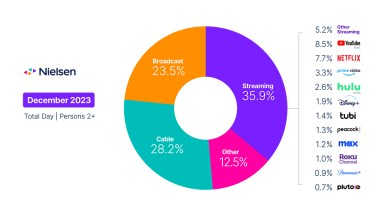
Charlie Buchwalter, SVP Research & Analytics, Nielsen Online
SUMMARY: The longer-term prospects for the global online medium continue to be bright. Led by social media, search, video and the continued online ramp up of the leading marketers, online’s share of total advertising spend will continue its steady upward trend as we emerge from the current recession.
Discussing the trajectory of the online medium in the midst of an historic economic downturn is a perilous business. Assaulted every day with downward-facing red arrows, many of the indicators concerning all things digital veer to the negative:
- Online media’s “favorite child” status (i.e., a long track record of outstripping the growth of every other medium by a wide margin) appears to have diminished over the past few months.
- Online advertising by the Financial Services, Retail and Auto industries has shrunk at a dizzying pace over the past six months.
- Online display advertising’s share of revenue has plateaued at 20% of total online ad spend in the U.S., and no panacea appears to be on the horizon.
- Despite online video’s persistent positive buzz, actual usage is averaging around six minutes per day in the U.S.
- The social media trend is today’s industry darling, but a monetization formula continues to elude the globe’s brightest marketers.
| Online access has moved from being a luxury to an essential requirement… |
But even the most cynical observer has to be swayed by positive developments that define the longer-term opportunities for the online medium and the e-commerce channel. Around the globe, the online population is looking more and more like the overall population—meaning that in a few short years, online access has moved from being a luxury or something cool to an essential, basic requirement. In addition, packaged goods manufacturers, pharmaceutical companies and telecommunications firms—historically three of the largest spenders on traditional media—are moving online at a pace not seen before, even as the recession continues to deepen.
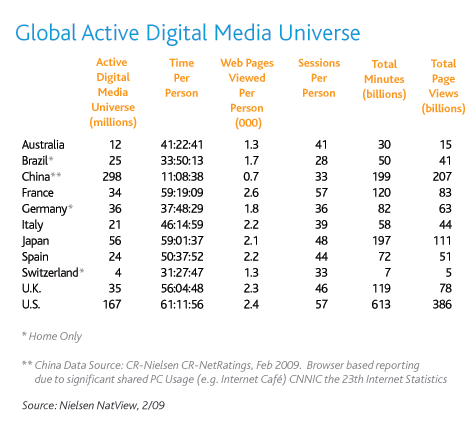
The audience growth and engagement quotient of online video is forcing marketers to positively re-assess the value of the online experience. Adoption of social networking capabilities, by both consumers and corporations, has crossed the chasm in what appears to be the blink of an eye. In the age of Twitter, feedback barriers have all but disappeared, creating a near friction-free environment for playing back brand experience, campaign reactions or brand events.
Search continues to be an indispensable tool for all online denizens and opportunities for additional growth continue to emerge. Search across social media networks is likely to be the next opportunity for search engines. And as consumers increasingly turn to their phones for a wide range of online content—improved network speeds and rising smartphone penetration helped to grow the mobile web in the U.S.—prospects continue to improve.
| Online will once again outperform all other media in terms of growth… |
Bright future
While 2009 will not be a banner year for online advertising revenues, online will once again outperform all other media in terms of growth. China will likely be flat to down, partially due to the global slowdown, but more importantly, because it will be hard to match the Olympics-related surge during 2008. The U.S. and Japan will be flat to slightly up. There will be pockets of significant (+25%) growth, but it will be limited to small-to-mid-sized advertising countries such as Brazil, and throughout Eastern Europe and Southeast Asia.
The longer-term prospects for the global online medium continue to be bright. Led by social media, search, video and the continued online ramp-up of the leading marketers, online’s share of total advertising spend will continue its steady upward trend as we emerge from the current recession. And given the increased focus on all things digital by the leading packaged goods companies, online’s share of commerce will continue to rise as well.
| Brands see opportunity to exploit the digital environment… |
When all is said and done, brands see tremendous opportunity to increasingly exploit the digital environment to maximize brand-favorable media impressions, but they are starting to look at the mix more holistically. Consumer-generated content has gained inclusion into the “earned media” club of marketing preferences, and the big question going forward will be how paid and earned media share the marketing expenditure pie.
Growth leaders
Today, online video and social media lead the way in terms of growth. It is rare to see segments significantly grow from both an audience and an engagement standpoint, but there has been exceptional growth over the past couple of years in both video and social media sites. While Member Communities (i.e., social networking sites) have been garnering impressive audience numbers for the past five years, video audiences have been growing at meteoric rates, surpassing personal e-mail audiences in November 2007. And from a time-spent perspective, Member Communities surpassed personal e-mail for the first time in February 2009.
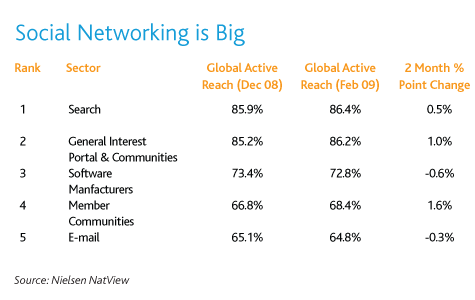
| Social networking sites eclipsed personal e-mail in global reach…
|
The growth in social media is the single most significant story in the online media space today. Social networking sites eclipsed personal e-mail in global reach at 68.4% vs. 64.8%, in February 2009. And even more significant—in only the first few months of 2009—the reach of these sites is growing at a brisk pace, faster than any other online sector.
Mobile moves
Of course, any discussion about online audience behavior would be incomplete without understanding the mobile dynamic. In the U.S. today, nearly 50 million mobile subscribers access the Web via mobile devices on a monthly basis. In the U.S., the mobile Internet audience grew 74% between February 2007 and February 2009. Internationally, the U.S. is one of the leading markets for mobile Internet penetration, with more than 18% of subscribers accessing mobile Web. This is the highest penetration of mobile subscribers among the markets for which Nielsen reports mobile Internet adoption, followed by the U.K., where nearly 17% of subscribers used mobile Web in Q1 2008.
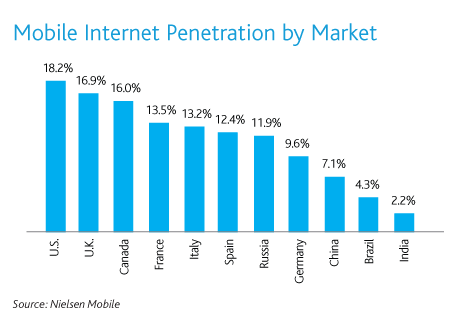
There’s an increasingly broad range of content consumed over mobile Web, too. While many initially expected the platform to be dominated by e-mail, news and weather, Nielsen’s latest U.S. mobile Internet research reveals a long tail of content interest. Portals, e-mail, weather and news do garner audiences of more than 20 million unique mobile users each, but categories such as food and dining, travel and health and fitness also attract millions of mobile Internet users each month.
Recessionary impact
From an advertising perspective, it seems funeral dirges for online display advertising were heard throughout 2008, and things went from bad to worse in the fourth quarter, when the bottom fell out of the economy and all forms of advertising were hammered. As the dreary holiday season came to a close and 2008 ended with a whimper, many were wondering if the days of online advertising’s favorite-child status were at an end.
| Online advertising overall did better than the doomsayers thought… |
While many other metrics registered all-time worst numbers in 2008, Nielsen reports that online advertising overall did a bit better than the doomsayers thought. Quarter four showed a 4.5% uptick from Q3, and a 2.6% increase from Q4 2007. And for the full year, online ad revenues grew more than 10%. Despite the slightly-better-than-expected year-end performance of online advertising, the true impact of the deep recession will be told in the 2009 numbers.
Global roundup
When scanning the globe, the country-by-country online advertising experience is a true patchwork quilt. The Scandinavian countries, Australia and China are clearly in the fast lane, while the U.K., France, Spain and Japan are moving ahead, but at a slower pace. Germany, Switzerland and Italy are barely growing, and the Benelux countries appear to be moving backwards.
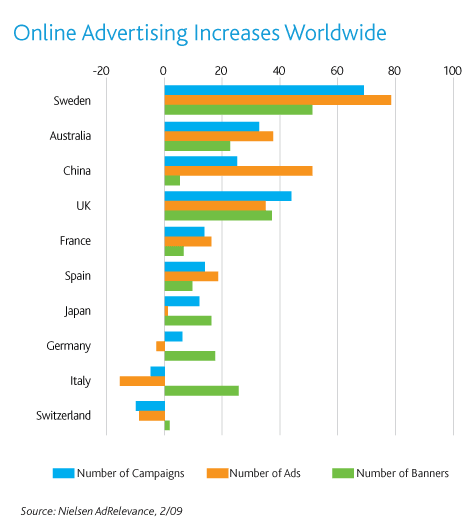
It’s clear that the global economic downturn is having an effect on all markets, and while online ad volumes appear to be brisk in some quarters, online ad rates are under such pressure that many advertisers are finding that rates from publishers are essentially the same rates they’re receiving from ad networks. As many of these international markets are starting from a significantly lower base of online advertising, their growth rates will outstrip the U.S. in many cases as the global economy picks up again.

